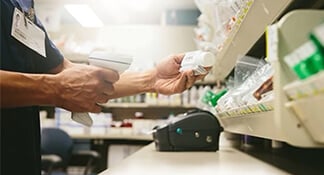Challenge
Like other healthcare organizations, Mercy Health System was concerned by the results of the 1999 study published by the Institute of Medicine, “To Err is Human,” which cited medication errors as the eighth leading cause of death in the United States. Administrators at St. Louis-based Mercy, the ninth largest not-for-profit healthcare system in the nation, suspected that any medication errors its hospitals experienced were less attributable to human error and instead more likely the result of inadequate internal processes.
Mercy decided to take a leadership role in reducing medication errors within its facilities. “We needed a way to help ensure that the right patient receives the right medication in the right dose at the right time,” says Curtis Dudley, executive director of optimization management for Resource Optimization & Innovation (ROi), Mercy’s supply chain operating division. “We believed most medication errors could be avoided by centralizing supply chain operations and implementing technology-based solutions such as bar coding.”
In response, representatives from a number of functional areas within Mercy, including nursing, the pharmacy, supply chain operations and IT, put their heads together to develop a more effective way to track medications throughout the supply chain-from the warehouse to the hospital pharmacy, nursing floors and, eventually, the patient.
Additionally, because pharmacists had to spend so much of their time checking that the correct medications were pulled from the pharmacy shelf, they had limited time to interact with physicians and patients. Mercy hoped that standardizing the pharmaceutical shipment process would enable its pharmacists to spend more time utilizing their expertise for patient care and less time on administrative tasks.
Solution
In 2001, as part of an organization-wide effort to reduce medication errors and improve patient outcomes, Mercy formed the Mercy Meds program, an innovative supply chain- driven, clinical patient safety initiative that serves Mercy’s 20 hospitals located throughout Oklahoma, Kansas, Missouri and Arkansas. The program was designed to enable Mercy to distribute all of its medical and pharmaceutical supplies from a single Consolidated Services Center based in Springfield, Mo., resulting in streamlined workflow, increased productivity and a reduction in medication errors.
After carefully considering the technology needs for Mercy Meds, Mercy chose printers from Zebra Technologiesto produce its bar code labels. Mercy had previously used Zebra printers in its supply chain operations and found them to be durable and easy to use. The organization deployed Zebra’s Z4M and TLP 3844-Z printers in its main distribution facility-to generate shelf, unit-dose medication and tote labels-and in all of its receiving docks to produce shipment tracking labels. The TLP 3844-Z printer accommodates a variety of label sizes and is used to create bar code labels for products that the manufacturer has not bar coded or to replace bar codes that won’t scan.
“Since our program is centered on patient safety, it was critical that we selected high quality, reliable printers that would produce clear bar codes with a high scan rate,” says Dudley. “Our Zebra printers have proven to be workhorses – generating thousands of labels each day while consistently producing crisp and highly scannable labels and requiring only minimal maintenance.”
When medications arrive at the service center, staff repackages the tablets or capsules into unit doses and then applies bar coded labels to the unit dose packages. If someone in the local hospital pharmacy scans the bar code label on a shelf that is low on inventory for a specific medication, a replenishment order for that medication is triggered. The automated medication cabinets on the nursing floor also generate a replenishment request when inventory reaches a predetermined minimum.
Once the replenishment order is received in the service center, a bar coded tote label containing the order fulfillment information is generated. A materials handler scans the tote label and pulls the required unit dose packages off the shelf and packs them in the tote bound for the hospital. A bar coded tracking label is applied to the tote, enabling the order to be tracked from the distribution center to the hospital site. “When the hospital receives the tote, the medications can go from the delivery truck to the medication cabinets on the patient floors without stopping in between, which is a huge time-saver,” says Doreen Northrup, manager of pharmacy services at Mercy.
Results
Whereas Mercy’s pharmacists once spent a great deal of time verifying medications, they can now devote more time to patient care. They are able to consult with physicians and clinicians and help them choose the best medication for the patient. For example, the pharmacist may recommend treating a condition with an oral dose instead of an IV solution or medication, which may reduce costs and lead to a better patient outcome. “We’ve equipped our clinicians with a process that ensures they are delivering quality care in a very safe manner to patients,” says Gene Kirster, COO of ROi.
Mercy Meds has also enabled Mercy to ensure that the right patient gets the right medication in the right dose at the right time-a key objective of the program. “We estimate that we have averted more than 17,000 potential medication errors annually-equivalent to a savings of approximately $14 million per year on litigation and treatment costs,” says Kirster.
The ability to automatically replenish inventory and reduce the amount of expired products are also strong benefits for Mercy. “We are able to manage inventory more strategically across the organization and keep products in locations where there is the greatest need,” says John Black, vice president of supply chain for ROi. Additionally, in the case of a prod- uct recall, staff can quickly locate and pull the recalled products, helping to ensure patient safety.
Today, Mercy hospitals receive one shipment per day from the Consolidated Services Center for all of their medication and medical supplies-a significant improvement when considering that in the past, each hospital could receive multiple shipments from multiple vendors each day. “Since implementing Mercy Meds, we have improved shipping accuracy by 50 percent and increased labor productivity by 20 percent,” says Black.
In the near future, Mercy plans to investigate the application of the Mercy Meds model to its medical and surgical products. In the meantime, the organization continues to focus on its mission of delivering compassionate, high quality clinical care. “It is satisfying to know that Mercy is concerned enough about its patients’ safety to invest in initiatives such as Mercy Meds,” says Kirster. “Ultimately, the program has enabled caregivers to spend more time doing what they do best-taking care of patients.”


